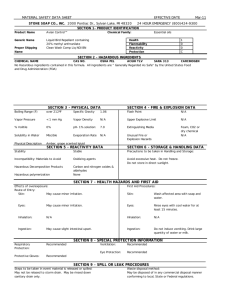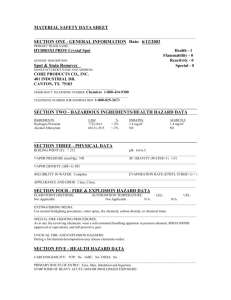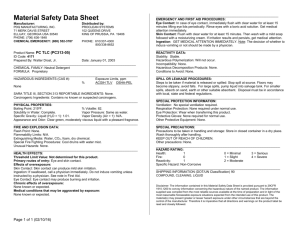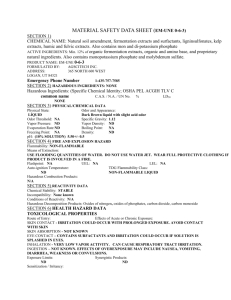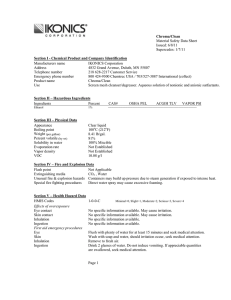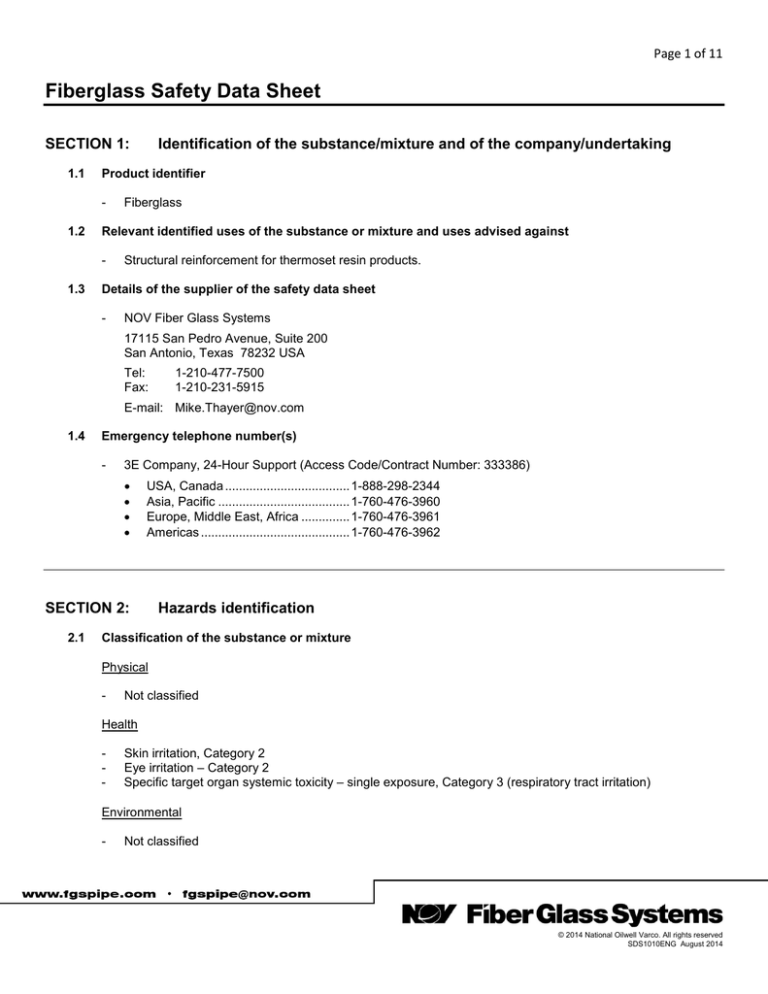
Page 1 of 11
Fiberglass Safety Data Sheet
SECTION 1:
1.1
Product identifier
-
1.2
Fiberglass
Relevant identified uses of the substance or mixture and uses advised against
-
1.3
Identification of the substance/mixture and of the company/undertaking
Structural reinforcement for thermoset resin products.
Details of the supplier of the safety data sheet
-
NOV Fiber Glass Systems
17115 San Pedro Avenue, Suite 200
San Antonio, Texas 78232 USA
Tel:
Fax:
1-210-477-7500
1-210-231-5915
E-mail: Mike.Thayer@nov.com
1.4
Emergency telephone number(s)
-
3E Company, 24-Hour Support (Access Code/Contract Number: 333386)
•
•
•
•
USA, Canada .................................... 1-888-298-2344
Asia, Pacific ...................................... 1-760-476-3960
Europe, Middle East, Africa .............. 1-760-476-3961
Americas ........................................... 1-760-476-3962
SECTION 2:
2.1
Hazards identification
Classification of the substance or mixture
Physical
-
Not classified
Health
-
Skin irritation, Category 2
Eye irritation – Category 2
Specific target organ systemic toxicity – single exposure, Category 3 (respiratory tract irritation)
Environmental
-
Not classified
© 2014 National Oilwell Varco. All rights reserved
SDS1010ENG August 2014
2.2
Label elements
Signal Word(s)
-
WARNING
Pictogram(s)
Hazard Statements
-
Physical
•
-
Health
•
•
•
-
Not classified
H315: Causes skin irritation.
H319: Causes serious eye irritation.
H335: May cause respiratory irritation.
Environmental
•
Not classified.
Precautionary Statements
-
Prevention
•
•
-
Response
•
-
No special instructions.
Disposal
•
2.3
P305+P351+P338: IF IN EYES: Rinse cautiously with water for several minutes. Remove contact
lenses, if present and easy to do. Continue rinsing.
Storage
•
-
P271: Use only outdoors or in well-ventilated area.
P280: Wear protective gloves/protective clothing/eye protection/face protection.
P501: Dispose of contents/container in accordance with regulatory requirements.
Other Hazards
-
PBT and vPvB assessment
•
None of the ingredients are considered to be either PBT or vPvB.
Page 2 of 11
SECTION 3:
3.1
Substances
-
3.2
Composition/information on Ingredients
Not applicable
Mixtures
Chemical Identity
Fibrous glass, continuous filament
Organic surface binder/sizing
SECTION 4.
4.1
CAS No.
EC No.
Concentration
Range (weight %)
065997-17-3
Not available
266-046-0
Not available
> 95
<5
First-aid measures
Description of first-aid measures
Inhalation
-
-
Move to fresh air.
If difficulty in breathing or respiratory irritation; seek immediate medical attention.
If breathing has stopped; seek immediate medical attention, perform artificial respiration.
Skin contact
-
Remove contaminated clothing.
Gently wash with plenty of soap and water.
If irritation develops or persists or if product becomes imbedded in skinn; seek medical attention.
Eye contact
-
Remove contact lenses, if present.
Immediately flush eyes with running water for at least 15 minutes, keeping eyelids open.
If irritation develops or persists, seek medical attention.
Ingestion
4.2
If swallowed and conscious, rinse mouth with water (never give anything by mouth to an unconscious
person).
If symptoms persist, seek immediate medical attention.
Most Important symptoms and effects, both acute and delayed
Acute
-
Dusts may cause temporary mechanical irritation to the eyes, skin, and respiratory tract. Accidental
ingestion may cause illness or irritation to the mouth and gastrointestinal tract.
Delayed
4.3
No specific data available.
Indication of any immediate medical attention and special treatment needed
-
Treat symptomatically.
Page 3 of 11
SECTION 5:
5.1
Extinguishing media
-
5.2
Use an extinguishing media suitable for the surrounding fire.
Specific hazards arising from the substance or mixture
-
5.3
No specific fire or explosion hazards.
Advice for firefighters
-
Wear self-contained breathing apparatus and protective clothing, as necessary.
SECTION 6:
6.1
Fiberglass is generally considered to be an inert solid; no special precautions identified.
Methods and materials for containment and cleaning up
-
6.4
Wear appropriate personal protective equipment and clothing to reduce or eliminate contact.
Environmental precautions
-
6.3
Collect spilled material by vacuum or sweeping and place into suitable container for disposal
Reference to other sections
-
See also, SECTION 8: Control parameters and SECTION 13: Disposal considerations.
SECTION 7:
7.1
Wear appropriate personal protective equipment.
Avoid eating, drinking, and smoking in areas where this material is handled, stored, and processed.
Wash face and hands before eating, drinking, and smoking after handling this product.
Conditions for safe storage, including any incompatibilities
-
7.3
Handling and storage
Precautions for safe handling
-
7.2
Accidental release measures
Personal precautions, protective equipment and emergency procedures
-
6.2
Firefighting measures
No specific data available.
Specific end use(s)
-
No additional data available.
Page 4 of 11
SECTION 8:
8.1
Exposure controls/personal protection
Control parameters
Glass Fiber (continuous filament glass fibers)
CAS No. 065997-17-3
Country
Occupational Exposure Limit (OEL) Values
Eight Hour TWA
3
2 mg/m (inhalable
dust)
Fifteen Minute STEL
Canada – British
Columbia
1 fiber/cc
None established
Canada - Ontario
1 fiber/cc
None established
Canada - Manitoba
1 fiber/cc
None established
Canada - Quebec
1 fiber/cc
None established
1 fiber/cc (respirable
fibers)
3
5 mg/m (inhalable
fraction)
3 fibers/cc (respirable
fibers)
3
10 mg/m (inhalable
fraction)
1 fiber/cc
None established
Australia
Canada Saskatchewan
New Zealand
None established
3
USA (ACGIH)
10 mg/m (fibrous
glass dust)
1 fiber/cc
USA (NIOSH)
3 fiber/cc
Singapore
None established
None established
None established
Legal Basis
Workplace Exposure Standards for
Airborne Contaminants
Occupational Health and Safety
Regulation, Table of Exposure Limits
for Chemical and Biological
Substances
Regulation 883, Control of Exposure
to Biological or Chemical Agents
Workplace Safety and Health Act,
Part 36
Regulation respecting occupational
safety and health
The Occupational Safety and Health
Regulations
Workplace Exposure Standards and
Biological Exposure Indices
Workplace Safety and Health
(General Provisions) Regulations
None
NIOSH Pocket Guide to Chemical
Hazards (Recommendations Only)
Particulates not otherwise classified/regulated (PNOC / PNOR) (may be generated if cured product is
subjected to sanding, grinding, cutting, etc.)
CAS No. – Not applicable
Occupational Exposure Limit (OEL) Values
Country
Legal Basis
Eight Hour TWA
Fifteen Minute STEL
Workplace Exposure Standards for
3
Austria
10 mg/m (inhalable)
None established
Airborne Contaminants
limites d'exposition professionnelle –
3
Belgium
10 mg/m
None established
VLEP/ Grenswaarden voor
beroepsmatige blootstelling – GWBB
3
10 mg/m (total)
Canada - Alberta
None established
Occupational Safety and Health Code
3
3 mg/m (respirable)
Occupational Health and Safety
3
Canada – British
10 mg/m (total dust)
Regulation, Table of Exposure Limits
None established
3
Columbia
3 mg/m (respirable)
for Chemical and Biological
Substances
3
10 mg/m (inhalable)
Workplace Safety and Health Act,
Canada - Manitoba
None established
3
3 mg/m (respirable)
Part 36
3
10 mg/m (inhalable)
Regulation 883, Control of Exposure
Canada - Ontario
None established
3
3 mg/m (respirable)
to Biological or Chemical Agents
Page 5 of 11
Canada - Quebec
3
10 mg/m (total dust)
None established
Regulation respecting occupational
safety and health
GBZ 2.1-2007, Occupational
exposure limits for hazardous agents
in the workplace
Code of Practice for the Safety,
Health and Welfare at Work
(Chemical Agents) Regulations
Occupational Safety and Health (Use
and Standards of Exposure of
Chemicals Hazardous to Health)
Regulations
Workplace Exposure Standards and
Biological Exposure Indices
Workplace Safety and Health
(General Provisions) Regulations
[Need reference]
None established
None
None established
29 CFR 1910 Subpart Z, Toxic and
Hazardous Substances
None established
EH40 Workplace exposure limits
None established
3
China
3 mg/m (fiberglass
reinforced plastic dust)
Ireland
10 mg/m (inhalable)
3
4 mg/m (respirable)
Malaysia
10 mg/m (inhalable)
3
3 mg/m (respirable)
New Zealand
10 mg/m (inhalable)
3
3 mg/m (respirable)
Singapore
10 mg/m (nuisance)
South Korea
10 mg/m
3
10 mg/m (inhalable)
3
3 mg/m (respirable)
3
15 mg/m (total dust)
3
5 mg/m (respirable)
3
10 mg/m (inhalable)
3
4 mg/m (respirable)
None established
3
None established
3
None established
3
USA (ACGIH)
USA (OSHA)
United Kingdom
8.2
3
3
None established
None established
Exposure controls
Appropriate engineering controls
-
Provide adequate general and local exhaust ventilation to control airborne concentrations to below the
occupational exposure limit values.
Personal protective equipment
-
Eye and face protection
-
-
Approved safety glasses with side shields (e.g., ANSI Z87, EN166)
Skin protection
Hand protection: Butyl rubber, Nitrile rubber or Neoprene gloves. Different glove materials,
thicknesses, and from different glove manufacturers may provide varying degrees of protection.
Temperature and specific use can impact glove effectiveness. Some gloves may be intended to be
used only once and then discarded, while others may be used for longer periods of time. The glove
supplier should provide the user with information regarding permeability and breakthrough time. Gloves
should be discarded and replaced if there is any indication of degradation or chemical breakthrough.
Other skin protection: Such clothing as to minimize or eliminate the chance of skin contact.
Respiratory protection
If ventilation is insufficient to keep airborne concentrations below the occupation exposure limit levels,
full or half-mask respirator fitted with particulate filters. Filter masks may be of limited use in cases of
high or unknown exposure.
Environmental exposure controls
-
Do not flush into surface water or sanitary sewer system.
Do not place directly onto ground.
Page 6 of 11
SECTION 9:
Physical and chemical properties
9.1 Information on basic physical and chemical properties
9.2
Appearance
Odor
Odor threshold
pH
Melting point/freezing point
Initial boiling point and boiling range
Flash point
Evaporation rate
Flammability (solid, gas)
Upper/lower flammability or explosive limits
Vapor pressure
Vapor density (air = 1)
Relative density
Solubility(ies)
Partition coefficient: n-octanol/water
Auto-ignition temperature
Decomposition temperature
Viscosity
Explosive properties
Oxidizing properties
White to yellowish solid
None
No data available
No data available
> 800°C (1472°F) / No data available
No data available
Not applicable
No data available
No data available
Not applicable
No data available
No data available
2.4 – 2.7
Insoluble
No data available
No data available
No data available
Not applicable
No data available
No data available
Other information
-
No data available.
SECTION 10:
Stability and reactivity
10.1 Reactivity
-
No data avaialble.
10.2 Chemical stability
-
Product is stable.
10.3 Possibility of hazardous reactions
-
Under normal conditions of storage and use, hazardous reactions will not occur..
10.4 Conditions to avoid
-
Excessive heat and flames.
Page 7 of 11
10.5 Incompatible materials
-
None known.
10.6 Hazardous decomposition products
-
Fiberglass products may release small amounts of acetic acid and other organic materials at elevated
temperatures.
SECTION 11:
Toxicological information
11.1 Information on toxicological effects
Acute toxicity
-
Data for ingredients were not found or not sufficient for classification.
Skin corrosion/irritation
-
Data for ingredients were not found or not sufficient for classification.
Serious eye damage/irritation
-
Data for ingredients were not found or not sufficient for classification.
Respiratory or skin sensitization
-
Data for ingredients were not found or not sufficient for classification.
Germ cell mutagenicity
-
Data for ingredients were not found or not sufficient for classification.
Carcinogenicity
-
Data for ingredients were not found or not sufficient for classification.
Reproductive toxicity
-
Data for ingredients were not found or not sufficient for classification.
STOT-single exposures
-
Respiratory system Irritation
STOT-repeated exposures
-
Data for ingredients were not found or not sufficient for classification.
Aspiration hazard
-
Data for ingredients were not found or not sufficient for classification.
Page 8 of 11
SECTION 12:
Ecological information
12.1 Toxicity
Acute toxicity
-
Data for ingredients were not found or not sufficient for classification.
Chronic toxicity
-
Data for ingredients were not found or not sufficient for classification.
12.2 Persistence and degradability
-
Data for ingredients were not found or not sufficient for classification.
12.3 Bioaccumulative potential
-
Data for ingredients were not found or not sufficient for classification.
12.4 Mobility in soil
-
Data for ingredients were not found or insufficient for classification.
12.5 Results of PBT and vPvB assessment
-
None of the ingredients are listed.
12.6 Other adverse effects
-
No additional data is available.
SECTION 13:
Disposal considerations
13.1 Waste treatment methods
-
Must be disposed of in accordance with local regulatory requirements.
SECTION 14:
-
Transport information
The transport information provided below conforms to the following:
UN Model Regulations
International Carriage of Dangerous Goods by Road (ADR)
International Carriage of Dangerous Goods by Rail (RID)
International Carriage of Dangerous Goods by Inland Waterways (ADN)
International Maritime Dangerous Goods (IMDG) Code
International Civil Aviation Organization (ICAO)Technical Instructions for the Safe Transport of Dangerous
Goods by Air
Page 9 of 11
If offered alone, the classification is
as described below
14.1 UN number
None
14.2 UN proper shipping name
Not regulated
14.3 Transport hazard class(es)
None
14.4 Packing group
None
14.5 Environmental hazards
None
14.6 Special precautions for user
None
14.7 Transport in bulk according
to Annex II of MARPOL 73/78
and the IBC Code
Product is not offered nor intended to
be transported in bulk quantities.
SECTION 15:
Regulatory information
15.1 Safety, health and environmental regulations/legislation specific for the substance or mixture
The regulatory information provided below may not be comprehensive.
Canada
Controlled Products Regulation (CPR)
This product has been classified in accordance with the hazard criteria of the CPR and the MSDS contains
all of the information required by the CPR.
Ingredient Disclosure List (IDL)
All components of this mixture that are on the IDL above their specified concentration are disclosed in this
SDS.
United States
EPCRA
Section 302
(EHS) TPQ
(LB/KG)
Section 304
RQ
(LB/KG)
Section 313
CERCLA
RCRA
CAA
OSHA
RQ
(LB/KG)
P/U Codes
112(r) TQ
(LB/KG)
Highly
Hazardous
Chemical
None of the ingredients are listed
15.2 Chemical safety assessment
-
No chemical safety assessment has been carried out for this mixture by the supplier.
Page 10 of 11
SECTION 16:
Other information
Revision history
Revision
Number
Revision Date
Revision Description
1
25-AUG-2013
Initial SDS creation in conformance with OSHA hazard communication
standard (29 CFR 1910.1200), Regulation (EC) No. 1907/2006 (REACH), and
UN Globally Harmonized System (GHS).
Legend to abbreviations and acronyms used
-
ACGIH
American Conference of Governmental Industrial Hygienists
-
ANSI
American National Standards Institute
-
CAA
Clean Air Act
-
cP
centipoise
-
CFR
Code of Federal Regulations (US)
-
EPCRA
Emergency Planning and Community Right-to-Know Act
-
IARC
International Agency for Research on Cancer
-
IBC Code
International Bulk Chemical Code
-
MARPOL
Marine Pollution
-
NIOSH
National Institute for Occupational Safety and Health
-
NTP
National Toxicological Program
-
OSHA
Occupational Safety and Health Administration (US)
-
PBT
Persistent Bioaccumulative and Toxic
-
RCRA
Resource Conservation and Recovery Act
-
vPvB
very Persistent and very Bioaccumulative
Key literature references and sources for data
-
ESIS. European chemical Substances Information System. http://esis.jrc.ec.europa.eu/.
-
USEPA. 2006. List of Lists, Consolidated List of Chemicals Subject to the Emergency Planning and Community
Right-To-Know Act (EPCRA) and Section 112(r) of the Clean Air Act. EPA 550-B-01-003. October 2006.
Page 11 of 11

